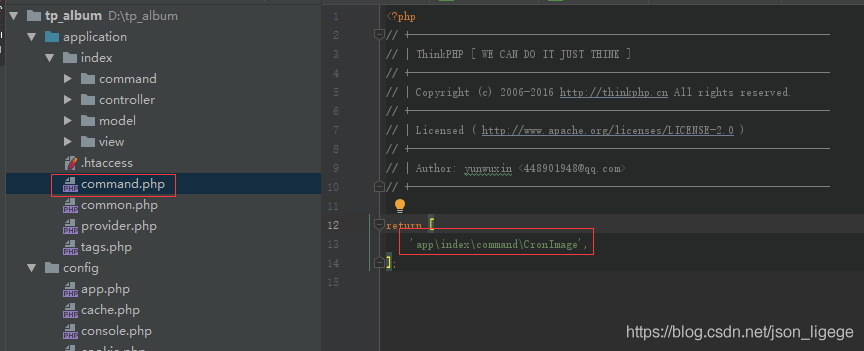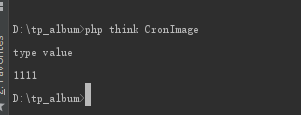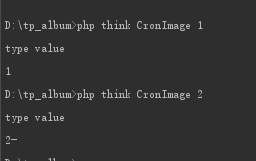??????????????????????? ThinkPHP5.1定时任务设置及传参
?
1.在相关模块中创建command文件夹,与controller/model/view目录同级

?2.在command中创建任务文件
<?php
namespace app\index\command;
use think\console\Command;
use think\console\Input;
use think\console\Output;
class CronImage extends Command
{
protected function configure()
{
//setName与文件名称保持一致 setDEscription则是说明
$this->setName('CronImage')->setDescription("设置图片表测试数据");
}
/**
* 业务逻辑
* @param Input $input
* @param Output $output
* @return int|void|null
*/
protected function execute(Input $input, Output $output)
{
}
}
3.在command.php中添加你所创建的任务文件的路径

?4.命令行中执行
任务文件中修改执行方法
/**
* 业务逻辑
* @param Input $input
* @param Output $output
* @return int|void|null
*/
protected function execute(Input $input, Output $output)
{
$output->writeln('type value');
echo 1111;
}
然后命令行 执行以下命令
php think CronImage
输出:

5.设置参数及获取参数(当同一个任务文件执行多个不同任务时)
<?php
namespace app\index\command;
use think\console\Command;
use think\console\Input;
use think\console\input\Argument;
use think\console\Output;
class CronImage extends Command
{
protected function configure()
{
$this->addArgument('type', Argument::REQUIRED); //必传参数
//$this->addArgument('type', Argument::OPTIONAL);//可选参数
$this->setName('CronImage')->setDescription("设置图片表测试数据");//setName与文件名称保持一致 setDEscription则是说明
}
/**
* 业务逻辑
* @param Input $input
* @param Output $output
* @return int|void|null
*/
protected function execute(Input $input, Output $output)
{
$output->writeln('type value');
$type = $input->getArgument('type');
switch($type)
{
case 1:
echo 1;
break;
case 2:
echo '2-';
break;
}
}
}
执行:

输出为不同的内容,可用来执行不同的业务逻辑,本文章到此已经结束!
cs





